-
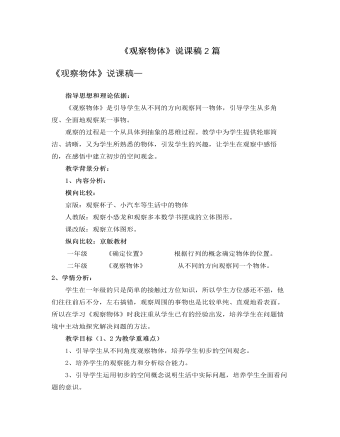
北师大版小学数学三年级上册《观察物体》说课稿2篇
3、认识正画、上面、右面。为了培养学生的自主学习能力,在这一活动中,首先我与学生交谈:“同学们,你们知道吗,刚才我们看到的物体的三个面都有自己的名字。”然后大胆放手,指导学生阅读教材,寻找答案;接着通过指认长方体纸箱、讲桌及班级中可能有的长方体物品的三个面加以理解,最后变换某一物品的摆放方向,请学生再次指认各面,使学生明白所谓的“正面、右面、上面”是会发生变化的。三、巩固练习,深化认识重视生活应用,让学生实践数学,学以致用是数学教学的一个重要原则。针对这一原则,在这个环节中,我安排了一组梯度式练习题:巩固深化题。教材26页的“连一连”、27页“练一练”中的1、3题;实际应用题。看图猜物、小小摄影师;课外延伸题。鼓励学生回家后与家长一起观察生活中的一件物体,试着把看到的形状画下来,结合着画为家长讲一讲本节课学到的知识。
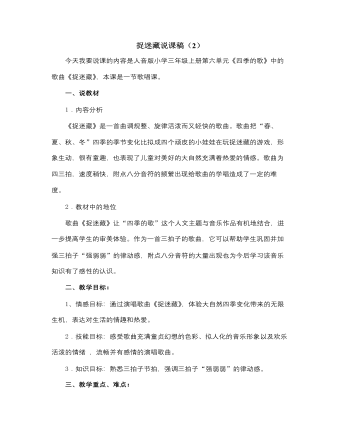
人音版小学音乐三年级上册捉迷藏说课稿(2)
三、拓展延伸1.游戏表演(春夏秋冬四个头饰)请四位学生分别扮演春夏秋冬四个娃娃,前半部分每个娃娃站在对应的小组前带领同学打三拍子节拍,后半部分下面同学根据歌词扮演花丛、草帽、谷堆、棉褂褂,四位学生自由躲藏。(设计意图:在游戏活动中进一步巩固三拍子“强弱弱”的律动感,调动学生表演的热情,寓教于乐。)2.歌曲综合处理,加入说唱、分组演唱等形式,分组讨论,最后选出最佳表演方案进行全体表演。(设计意图:运用参与体验法发挥学生的主体作用,引导学生利用之前教学中设计的说唱等形式进行综合表演,发挥学生的创造性,并通过相互合作表现歌曲。)四、小结师生谈话,渗透热爱大自然,保护环境的意识,在《捉迷藏》的歌声中结束本课教学。(挖掘教材中蕴含的更深层次的东西,结合生活实际进行情感教育,争取让学生在课堂上有更多的收获。)
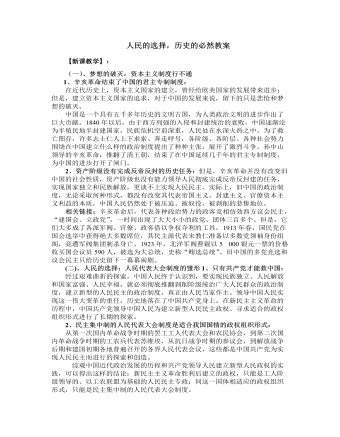
人教版高中政治选修3人民的选择,历史的必然教案
(三)、历史的必然:人民代表大会制度的确立1、《中国人民政治协商会议共同纲领》作为临时宪法规定我国根本政治制度是人民代表大会制度。新中国的成立,标志着亿万中国人民真正成为国家、社会和自己命运的主人。此前召开的中国人民政治协商会议第一届全体会议,为建立新型国家政权发挥了重大作用,会议通过的《中国人民政治协商会议共同纲领》具有临时宪法的地位,为全国人民代表大会制度的建立奠定了法律基础。共同纲领规定:中华人民共和国的国家政权属于人民,人民行使国家权力的机关为各级人民代表大会和各级人民政府。2、人民代表大会制度在我国正式建立起来的标志:1954年9月15日,第一届全国人民代表大会第一次会议在北京召开,会议通过了《中华人民共和国宪法》,标志着人民代表大会制度在我国正式建立起来。

人教版新目标初中英语七年级下册What does he look like教案3篇
所需要用到的句子:Who is that?That is Jack. I like him.Why do you like him?I like him because he is interesting.Task 4: 设计理想中的人类Step one: 设计理想中的人类的外貌。把全班同学分成若干小组,学生可以边说边在纸上画出他们的模样。Step two: 设计理想中人类的性格。学生们可以把那些能描述性格的单词写在图画的旁边。Step three: 每组选出一名同学,其他同组同学提问,他作简单回答,并说明原因。所需用到的句子:What does he or she look like?He or she ...What is he or she like?He or she is ...Why?Because ...Task 5: 挑战性活动调查性格是天生的还是后天形成的,让每个同学回家去调查一下自己成长过程中性格是否有变化,具体是怎样的,为什么会这样? Teaching Aims:1. Enable students to have a general understanding of how to talk about people's physical appearance.2. Enable students to tackle some essential vocabularies and patterns about describing people. Provide them with necessary skills and methods.3. Create various chances for students to describe the persons they're familiar with, such as classmates, family members, teachers, idols, etc.

人教版新目标初中英语八年级上册Can you come to my party教案3篇
Step 3 (3b)First, tell the students when we talk about our future plans, we often use: I’m+verb+ing When we talk about what we must do, we use have to. Ask the students to fill in the blanks in 3b. The answers are: shopping, go to see, a test, I’m going, my family. Step 4 (3c)Let the students write an e-mail message to a friend. Say why you can’t visit next. Before the exercise, ask the students to give some possible answers and write them on the blackboard. So the students will feel easy to finish the writing exercise. After they finish it, Let them to correct it in groups first. Each group chooses theirs best one to read in front of the whole class. Step 5 ( planning a party )First read the conversation in the box together. Then ask the students to turn to page 88.Write down everything you have to do next week. Write in all the things you have to do . Ask the students to look at the list. Ask them “What day are you free?” This is when you can have your party. Step 6 (Self check 1 )Let the students to fill in the blanks with the words given. Change the forms of the words if possible. Then make their own sentences. The answers are: visit, playing, have to, study, comeStep 7 (Self check 2)Imagine you are Marie. Read the information and look at your schedule. Write replies to the invitation.

人教版新目标初中英语八年级上册Could you please clean your room教案3篇
一、 教学内容Section A 1a----1c二、 教学目标1.学习词汇do the dishes, make the bed, take out the trash, fold the clothes, do the laundry, sweep the floor, clean the living room.2.句型 Could you please clean your room? Yes, sure.三、 教学准备 学生预习本单元所有的词汇多媒体课件 活动表 奖品四、 教学过程Pre-task1. Warming upEnjoy ourselves. Watch cartoon Cinderella. 看动画片段《灰姑娘》导如入本课话题和新词汇“chores”美丽善良的鬼姑娘因继母的嫉妒,每天得做所有的家务。片段的主题使学生联想到本课的话题。2. learn new words and phrasesLook! What is she / he dong? 看图学习动词词组do chores, do the dishes, make the bed, take out the trash, fold the clothes, do the laundry, clean the living room.3. Guessing game.What is she doing ? 4. Pair work. 1a, Do you do these things at home? Write “Y” for “yes” and “N” for “no”.5. Listening . 1b , Peter’s chores or Mom’s chores?理解目标语Could you please clean your room? Yes, sure.Write “M” for Mom’s chores, “P” for Peter’s chores in the chart.6. PairworkLook at the picture,Ask your partner to do the chores that you see. 7. Interview Who is the most able at home? 1) What chores do you do at home? How often do you do the chores? Work in four, interview each of the students in the group, fill in the chart.

人教版新目标初中英语八年级上册I’m going to be a basketball player教案3篇
教学目标1.知识目标:(1)学习What are you going to be when you grow up?/How are you going to do that?句式。(2)学会用英语描述有关职业的表达法。2.能力目标:(1)能够谈论为实现理想所做出的打算和安排。(2)能够谈论未来自己与他人理想的职业及原因。(3)能用英语描述课余时间的活动安排,最终具备表达综合信息的能力。3.情感目标:新学期到来之际,让他们在学习、体育、饮食、特长、读书等方面制定计划,教育学生合理安排自己的课外生活,思考自己的理想职业及适合自己的职业。教学重点、难点本单元的重点为“be going to”表将来,want to be, what,where, when,how引导的特殊疑问句。难点是语言目标的实现。教材分析本单元以I am going to be a basketball player为话题,共设计了三部分的内容:一、Section A该部分有4个模块。第一模块围绕Do you think these jobs are interesting?这一话题展开思维(1a)、听力(1b)、口语(1c)训练;

人教版高中数学选修3离散型随机变量及其分布列(2)教学设计
温故知新 1.离散型随机变量的定义可能取值为有限个或可以一一列举的随机变量,我们称为离散型随机变量.通常用大写英文字母表示随机变量,例如X,Y,Z;用小写英文字母表示随机变量的取值,例如x,y,z.随机变量的特点: 试验之前可以判断其可能出现的所有值,在试验之前不可能确定取何值;可以用数字表示2、随机变量的分类①离散型随机变量:X的取值可一、一列出;②连续型随机变量:X可以取某个区间内的一切值随机变量将随机事件的结果数量化.3、古典概型:①试验中所有可能出现的基本事件只有有限个;②每个基本事件出现的可能性相等。二、探究新知探究1.抛掷一枚骰子,所得的点数X有哪些值?取每个值的概率是多少? 因为X取值范围是{1,2,3,4,5,6}而且"P(X=m)"=1/6,m=1,2,3,4,5,6.因此X分布列如下表所示
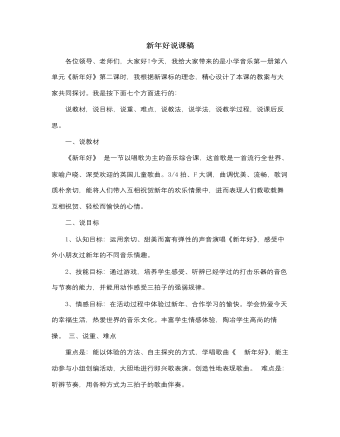
人音版小学音乐一年级上新年好说课稿
一、说教材《新年好》 是一节以唱歌为主的音乐综合课,这首歌是一首流行全世界、家喻户晓、深受欢迎的英国儿童歌曲。3/4拍、F大调,曲调优美、流畅,歌词质朴亲切,能将人们带入互相祝贺新年的欢乐情景中,进而表现人们载歌载舞互相祝贺、轻松而愉快的心情。二、说目标1、认知目标:运用亲切、甜美而富有弹性的声音演唱《新年好》,感受中外小朋友过新年的不同音乐情趣。2、技能目标:通过游戏,培养学生感受、听辨已经学过的打击乐器的音色与节奏的能力,并能用动作感受三拍子的强弱规律。3、情感目标:在活动过程中体验过新年、合作学习的愉快。学会热爱今天的幸福生活,热爱世界的音乐文化。丰富学生情感体验,陶冶学生高尚的情操。 三、说重、难点重点是:能以体验的方法、自主探究的方式,学唱歌曲《 新年好》,能主动参与小组创编活动,大胆地进行即兴歌表演。创造性地表现歌曲。 难点是:听辨节奏,用各种方式为三拍子的歌曲伴奏。
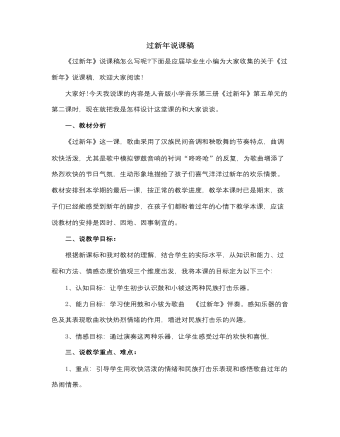
人音版小学音乐二年级上册过新年说课稿
经过“十”字步的学习知道东北秧歌的基本步伐。8、 演一演 让孩子们用舞蹈表现歌曲,拿起手帕扭秧歌、以及用打击乐器为歌曲进行伴奏,演示一遍,把全课推向高潮。七、教学启示总之,在本方案的设计中,我力求体现以人为本的思想,着眼于学生的主动发展,致力于运用现代信息技术优化课堂教学的研究,淡化学科边缘,通过充分的音乐实践培养学生的能力,提高音乐素养。依托音乐本身的魅力,影响学生人生观、审美观、价值观的形成。全面影响学生做人、做事的态度,培养学生主动学习、合作意识、探究精神。从目标的提出、到过程的安排、学习方法的确定、乃至学习成果的呈现,都让学生有更大的自主性、更多的实践性、更浓的创造性。当然,措施付诸实施,还需要老师的爱心和慧心,教学研究永无止境,我相信,没有最好,只有更好。在此,还请各位领导和同行们提出宝贵意见,谢谢!
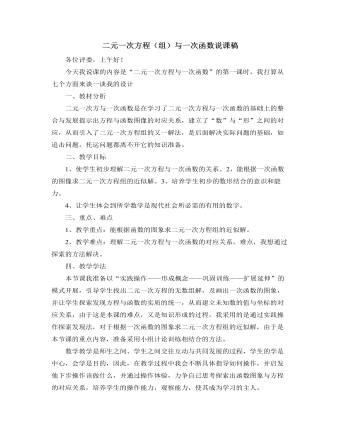
北师大版初中八年级数学上册二元一次方程(组)与一次函数说课稿
在第1环节基础上,再让同学认识到函数Y=2X-1的图象与方程2X-Y=1的对应关系,从而把两个方程组成方程组,让学生在理解二元一次方程与函数对应的基础上认识到方程组的解与交点坐标的对应关系,从而引出二元一次方程组的图象解法。3、例题训练,知识系统化通过书上的例1,用作图象的方法解方程组,让学生明白解题步骤与格式,从而规范理顺所学的图象法解方程组,例题由师生合作完成,由学生说老师写的方式。4、操作演练、形成技能让学生独立完成书P208随堂练习,给定时间,等多数学生完成后,实物投影其完成情况,并作出分析与评价。5、变式训练,延伸扩展通过让学生做收上P208的试一试,而后给一定时间相互交流,并请代表发言他的所悟,然而老师归纳总结,并让学生通过自已尝试与老师的点拔从“数”与“形”两个方面初步体会某些方程组的无解性,进一步发展学生数形结合的意识和能力。6、检测评价,课题作业
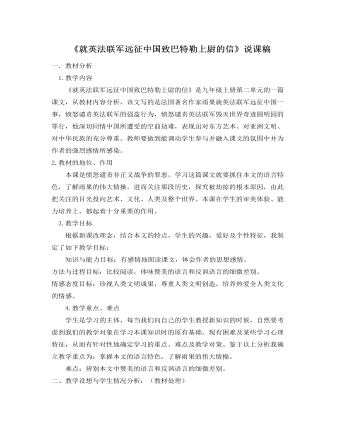
部编版语文九年级上册《就英法联军远征中国致巴特勒上尉的信》说课稿
1.教学内容《就英法联军远征中国致巴特勒上尉的信》是九年级上册第二单元的一篇课文,从教材内容分析,该文写的是法国著名作家雨果就英法联军远征中国一事,愤怒谴责英法联军的强盗行为,愤怒谴责英法联军毁灭世界奇迹圆明园的罪行,他深切同情中国所遭受的空前劫难,表现出对东方艺术、对亚洲文明、对中华民族的充分尊重。教师要做到能调动学生参与并融入课文的氛围中并为作者的强烈感情所感染。2.教材的地位、作用本课是愤怒谴责非正义战争的罪恶,学习这篇课文就要抓住本文的语言特色,了解雨果的伟大情操。进而关注那段历史,探究被劫掠的根本原因,由此把关注的目光投向艺术、文化、人类及整个世界。本课在学生的审美体验、能力培养上,都起着十分重要的作用。3.教学目标根据新课改理念,结合本文的特点,学生的兴趣,爱好及个性特征,我制定了如下教学目标:

新人教版高中英语选修2Unit 2 Bridging Cultures-Discovering useful structures教学设计
The grammar of this unit is designed to review noun clauses. Sentences that use nouns in a sentence are called noun clauses. Nominal clauses can act as subject, object, predicate, appositive and other components in compound sentences. According to the above-mentioned different grammatical functions, nominal clauses are divided into subject clause, object clause, predicate clause and appositive clause. In this unit, we will review the three kinds of nominal clauses. Appositive clauses are not required to be mastered in the optional compulsory stage, so they are not involved.1. Guide the students to judge the compound sentences and determine the composition of the clauses in the sentence.2. Instruct students to try to learn grammar by generalizing grammar rules, controlling written practice, and semi-open oral output.3. Inspire the students to systematize the function and usage of noun clause1.Instruct students to try to learn grammar by generalizing grammar rules, controlling written practice, and semi-open oral output.2.Inspire the students to systematize the function and usage of noun clauseStep1: The teacher ask studetns to find out more nominal clauses from the reading passage and udnerline the nominal clauses.

人音版小学音乐一年级下音的高低说课稿
(3)请学生用自己的声音模拟大钟、小钟,并按节奏谱读谱。(让学生通过歌谣中对大钟、小钟的声音长短的变化,体会大钟和小钟声音高低的特点。教师还要注意提示学生,在读歌谣过程中除了声音要模仿准确,节奏也要模仿准确。)(4)请学生选用乐器来模拟小钟的声音?(踫钟、三角铁)(5)老师用钢琴的低音模拟大钟的声音,其他同学按节奏读谱。教师要求:在教师与学生合作读节奏谱过程中,教师要提示学生:第一,心里要有节奏,速度不能忽快忽慢。第二,没有拿到乐器的同学在读谱过程中,不要忘记模拟大钟、小钟声音的高低。(6)教师与学生合作共同读谱并用乐器模拟大钟、小钟声音。三、课堂小结声音的世界真神奇,有了高低不同、音色不同的神奇声音,把我们的生活装扮得很有趣。今天,我们了解了用“高”、“低”来分辨声音的音色特点。老师给同学们留一个作业,请你试着用声音高低不同的乐器或是动物来创编新歌谣的歌词。
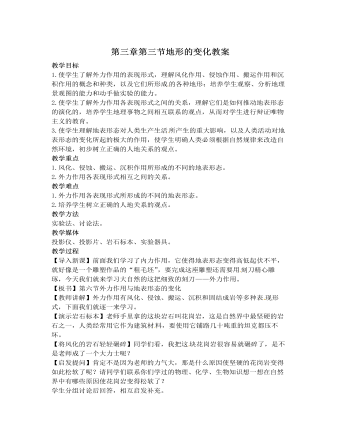
人教版高中地理选修1第三章第三节地形的变化教案
在自然界也是如此,可以看到砾石、沙、粉砂、粘土等颗粒大小不同的沉积物。【出示投影片提问】(河流下游三角洲示意图)这是一幅河流下游三角洲的示意图,你能用沉积作用的原理来解释它的形成过程吗?学生讨论、回答。【教师小结】河流携带着大量的泥沙,到达下游时由于流速降低,泥沙大量沉积,常常会形成宽广平坦的三角洲和冲积平原。在那里土壤肥沃,灌溉便利,通常是良好的农业区。【转折过渡】流水的沉积作用给人类带来了肥沃的冲积平原,风力的沉积作用给人类又带来了什么呢?【分析讲解】在沙漠中有大量的沙丘,这些沙丘在风力作用下会成为流动沙丘,掩没农田和村庄,甚至是整个城市。人类正在探索控制沙漠扩展的方法。【转折过渡】沉积物经过物理的、化学的以及生物化学的变化和改造,又会重新变成坚硬的岩石,这种作用叫做团结成岩作用。
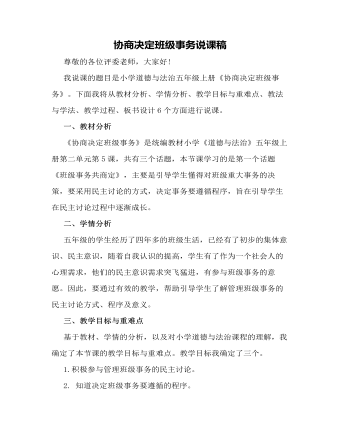
人教部编版道德与法制五年级上册协商决定班级事务说课稿
教师再次用课件出示活动二中民主讨论的这个案例,引导学生说说,在对班级重大事务决策时,采用这种民主讨论方式有什么意义?板书:民主讨论的意义。设计意图:引导学生了解民主讨论能为班级创设宽松、和谐的氛围,让每个人都能畅所欲言,充分发表自己的意见。在这一过程中,学生也逐渐成长。环节三:课堂小结,内化提升学生谈一谈学习本节课的收获,教师相机引导。设计意图:梳理总结,体验收获与成功的喜悦,内化提升学生的认识与情感。环节四:布置作业,课外延伸写下对自己班级的美好寄语。设计意图:将课堂所学延伸到学生的日常生活中,有利于落实行为实践。六、板书设计为了突出重点,让学生整体上感知本节课的主要内容,我将以思维导图的形式设计板书:在黑板中上方的中间位置是课题《协商决定班级事务》,下面是:民主讨论,决定班级事务要遵循的程序,民主讨论的意义。

人教版新目标初中英语七年级下册Where is the post office教案2篇
Period 2 (3a----Section B 2c)Preview(Pre-task): Key points: What laAdd another information about their pen pals----their language on the cardnguage does she/he speak?She/He speaks....Does she/he have any brothers and sisters? Does she/he speak English?Preview(Pre-task): Add another information about their pen pals----their language on the cardKey points: What language does she/he speak?She/He speaks....Does she/he have any brothers and sisters? Does she/he speak English?Step 1 Revision1.Revisionand dictation of the new words 2.Revise the drills they learned yesterday.(by pairwork and grammar exercise)Step 2 Leading-inT has a conversation with one student. The conversation is following:---Do you have a pen pal?---Yes, I do.---What's your pen pal's name? ---His/Her name is....---Where is your pen pal from? ---He/She is from...---Where does he/she live? ---He/She lives in....---What language does he/she speak?He/She speaks...Write the new words on the Bb. They are following: EnglishChineseJapaneseFrenchStep 3 LearnLearn the new words with the whole class.Finish 3a with the students3b Pairwork T still does an example with one student Then the Ss practise in pairs. The example is following:--Curry Muray is my pen pal. He is from the United States.---What language does he speak?

人教版新目标初中英语七年级下册Why do you like koalas教案2篇
单元整体说明(一)单元教材分析本单元的核心话题是描述动物和表达个人喜好,以及句式why do you like…? Because…。这也是本单元的教学重点。通过本单元的学习,学生应能较流利地运用所学词汇和句型描述动物,表达个人喜好。(二)单元知识结构1.词汇动物名称 tiger, elephant, koala, dolphin, etc.词汇描述性形容词: smart, cute, ugly, clever, shy, etc.国家名: Australia, South Africa2.句型Why do you like koala hears? Because they are cute.Where are pandas from? They're from China.What animals do you like? I like dolphins.(三)单元整体目标1.Master the vocabulary2.Master and use: Why do you like koalas? Because they am cute.Where are pandas from? They're from China.What animals do you like? I like dolphins.(四)单元教学重难点一览(五)单元学情分析学生此前已经学过由why, where, what 引导的特殊疑问句句型,具有了学习本单元知识的认知前提。形形色色的动物能激发学生的好奇心,产生了解它们的欲望,这有利于本单元知识的教学和学生学习兴趣的培养。

人教版新目标初中英语八年级上册How was your school trip教案2篇
“Go for it!” is based on “Task-Based Language Teaching”. It adheres to “The authenticity principle”, “The form-function principle”, “The task dependency principle” and “The principle of learning by doing”. These principles all accord with the demands of curriculum focus.In and of Grade Seven (II), “Go for it!”, students have learned “The Simple Past Tense”. And it appears again in of Grade Eight (I). teaches students more about how to talk about events in the past. In addition, it gives affirmative and negative statements in the past tense, such as the sentence patterns “Did you see …?” “Were there …?” “Did you go …?” As the first part of Unit 8, Section A opens with a picture presenting the last school trip in the aquarium and continues with several step-by-step practice activities, which are all good for students to master “The Simple Past Tense”. Doing well in Section A will help students integrate the new target language with that in Section B. Thus, they can describe the events in the past freely and foster their own ability of reflecting and practicing. II. Teaching ObjectivesTeaching objective is the beginning and aim of teaching activities. According to the overall goal of the English elementary course--- improve students' synthetic ability of language application, which should be based on the development of students’ “Language knowledge”, “Language skills”, “Character building”, “Learning strategies” and “Cross-cultural awareness”. The teaching objectives are described as follows(I). Knowledge objectivesi. Master the simple past tense of regular and irregular verbsii. Recite the new words and expressions about the last school trip in the aquarium, including their pronunciation and intonation

人教版新目标初中英语八年级上册I’m more outgoing than my sister教案2篇
1 交通工具的比较此活动为小组活动。学生通过讨论找出到达某一城市可乘坐的各种交通工具,并选择最佳出行方式。Teacher:We’re going to Shanghai. How many ways can we use to get there? Yes, there are four ways: by bus, by plane, by train, by ship. Please discuss how you are going to get there.操作建议:(1)学生以小组为单位展开活动,谈论本组所选择的交通工具。(2)各组选代表向全班汇报,阐述本组所选择的交通工具的利和弊。完成任务所需要的语言结构:We can go there by ship. It’s more comfortable and cheaper than any other transportation.We can go there by bus. It’s cheaper but it takes longer time.2 哪个城市更合适?此活动具有挑战性。假设中国要举行2014年世界杯足球赛,分别从历史,人文,天气等方面对各城市(北京,大连,上海,昆明)进行比较,选择最佳举办城市。T: Imagine China is holding the 2014 FIFA World Cup. Which city do you think is the best for the World Cup, Beijing, Dalian, Shanghai or Kunming? Let’s work in groups. If you choose Beijing, please join the Team Red. If you chose Dalian, please join the Team White. If you choose Shanghai, please join the Team Blue. If you choose Kunming, please join the Team Green. Please show us its advantages. Then let’s see which team will win.

